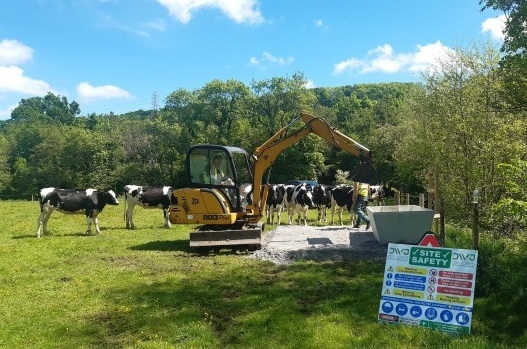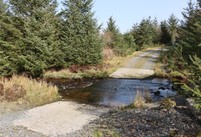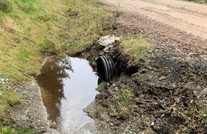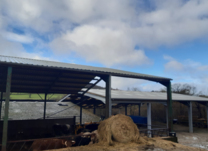|
Welcome to the Autumn issue of the LIFE Dee River newsletter!
A few highlights of what the project has achieved to date...

|
|

With great excitement, we are pleased to report that our recent electric fishing survey at Morlas Brook found that juvenile salmon were present at three different sites above the location of a concrete ford we removed last autumn! This indicates that returning adult salmon have accessed the brook last winter and managed to successfully spawn above the location of the ford removal.
Previous surveys in 2020 and 2021 found that juvenile salmon were present immediately below the ford, however none were captured above the ford, suggesting the structure was a barrier to migratory fish. Adult salmon return to their natal stream to spawn having spent time growing at sea. If their route is blocked by artificial structures, they can waste energy or sustain injuries attempting to pass and become more vulnerable to predators. The structure was only 60 metres from the confluence with the River Ceiriog, a large tributary of the River Dee, so it meant that virtually the whole of Morlas Brook was inaccessible in most years. By removing the ford, we have opened up the brook to allow returning adult salmon to access their spawning grounds – fantastic news for local salmon populations and the LIFE Dee River project. Watch the video here
|
|
|

When we carry out interventions such as weir removal or adaption, or improving riparian or in-river habitat, we try to demonstrate that our actions have had a positive impact. As part of this process, we undertake electric fishing surveys of SAC species such as juvenile salmonids, bullheads and lamprey. This usually involves collecting data before and after the intervention is taken, and if possible, the use of control sites - which indicate how fish numbers at the site may have reacted without our interventions. Electric fishing has been completed for the 2022 sampling season and has yielded some promising results, particularly in the River Ceiriog catchment.
Monitoring works post-intervention in the Ceiriog around Llanarmon D.C., Tregeiriog and the Brynkinalt estate have all delivered improvements. Electric fishing results are usually categorised using the National Fisheries Classification Scheme (NFCS) - ranking from F (no fish) to A (excellent).
The upper river sites remained at Grade C for salmon, despite a small increase in salmon fry numbers. However, trout have moved from Grade C to A, with an increase from 61 to 145 individuals in the last year! This shows the density of fish in the area has dramatically increased as we have re-introduced boulders back into the river to create more available habitats for fish. These numbers should improve further once we carry out work at Brynkinalt and Chirk weirs, improving access for migrating adult salmon and grilse.
Sampling in other catchments such as the Alwen were classed as ‘poor’ but were undertaken prior to the in-river interventions. We hope to see improvements here next year following our gravel introduction work detailed below.
|
|
|

During August and September, around 3,000 tonnes of river gravel and boulders have been introduced into the upper reaches of the Alwen, Brenig and Tryweryn rivers. This material has been introduced into these specific tributaries as they all have dams upstream which retain gravel and sediment which should be making its way downstream naturally. When rivers are starved of gravel it reduces spawning availability for migratory and resident fish. By introducing material into these river systems, it will not only vastly improve spawning opportunities for salmon and trout but it will also benefit the entire ecosystem. The addition of in-channel river gravels and boulders will help create diverse natural habitats for invertebrates to live and will provide much needed shelter for juvenile fish and other aquatic species.
Electric fishing surveys have been carried out prior to the work to establish a baseline against which we can monitor the impact of our work in future.
|
|
|

Fencing along river banks can significantly improve habitat for fish and other wildlife that is being damaged by livestock, such as cows and sheep. With the agreement of local landowners and tenant farmers, the project has fenced 3,450 metres of river bank in the lower reaches of the Ceiriog, from Chirk to the confluence with the River Dee. This section of river is now almost completely fenced off.
In the mid to upper reach, between Tregeiriog and Llanarmon D.C, 1,700 metres of fencing has also been installed. The type of fencing varies to suit the conditions, for example three strands for just cattle, stock mesh for lambs and sheep, plain and barbed horizontal wire where there is a flood risk, and inverted stock mesh where allowing the passage of pheasants is important.
Where livestock still need drinking water and mains water isn’t feasible, the project is installing and trialling two types of solar powered drink troughs, so far with encouraging results and minimal maintenance.
Exciting habitat improvements are already being seen. We are fully dependent on the cooperation and support from landowners and farmers to deliver this work, which we gratefully acknowledge.
|
|
|

Over the summer, our local contractors completed over 1,500 metres of fencing along the main river near Llangollen to stop cattle from poaching the banks and accessing the river, with the aim of reducing the nutrient and sediment input into the Dee as this has a detrimental effect on water quality.
We also discovered that a small stream, which flowed into the Dee, was being badly poached by cattle in a wooded area nearby. This stream had potential to be a good quality spawning site due to good water quality and the amount of gravel available. We cleared some of the woody material in the stream and other barriers that were there due to cattle damaging trees. A stock fence was erected around the wooded area to ensure that cattle could no longer gain access to the river here and erode the banks. As a reliable alternative water source for the cattle, we installed a solar powered drink trough which uses a suction pipe to pump water from the river into the trough. We look forward to seeing improvements to the riverside habitat here over the coming months.
|
|
|

On the 28th and 29th June 2022 we welcomed Dr Lynne Barratt, our external monitor working for NEEMO. NEEMO is responsible for the monitoring of LIFE projects that are funded through the EU’s LIFE programme. This was the first meeting in person, having had the previous two held virtually due to Covid restrictions. Following the visit we received a very supportive letter from the commission, congratulating the project on the positive work carried out to date.
Our ‘Mid-term’ report has also been submitted to CINEA, the European Climate Infrastructure and Environment Executive Agency. This technical and financial report addressed all work up to 31st December 2021 and will be assessed based on the original LIFE Dee River Grant Agreement deliverables, agreed in the application for the LIFE funding.
The report is currently under review by officers in Brussels, once verified we hope to receive our second payment from LIFE. If you would like to receive a copy of the report, please email lifedeeriver@cyfoethnaturiolcymru.gov.uk
|
|
|

1. The planning and design process for the river crossing at Penaran forestry block has been completed, with the construction of the crossing to begin soon, prior to any felling operations in the forestry block. Over the next 5 years it is estimated that approximately 25,000 tonnes of timber will be harvested and transported across this route. Currently, the only way for forestry machinery to cross the river is by driving directly through the watercourse, which leads to sediment and pollutants entering the watercourse, potentially harming spawning grounds further downstream. Installing the new crossing would stop an estimated 2,000 passes of articulated lorries having to directly drive through the watercourse during harvesting and transportation.
|

2. Culvert replacements at Aberhirnant and Llangower forestry block are currently underway as part of our efforts to improve water management at the forestry. Culverts are enclosed watercourses used to divert or drain water from land above it, and usually look like tunnels or large pipes. Installing new culverts will help reduce sediment and other contaminates from the forestry track from entering watercourses in the catchment, especially during flash flooding. The entire forestry block has been surveyed using a grading system which identified that 8 existing culverts will need to be replaced and an additional 3 new sites will also have culverts installed. Replacing these culverts before winter will help ensure that surface rain during the wetter months will be diverted and naturally filtered, reducing the potential for rainwater to run down forestry tracks and carry sediment into watercourses.
|

3. Over the winter months, several farm intervention projects will take place. During the Land Management Officers on-farm visits, they actively search to see if any of the farms would benefit from an on-yard intervention. This can include fitting new guttering or installing grids to prevent clean rain water from accessing slurry pits which increases the volume of slurry being produced, drastically impacting the capacity of the slurry storage unnecessarily. If you're in interested in finding out more, please email our Land Management Officers:
ifor.potts@cyfoethnaturiolcymru.gov.uk tomos.wynne@cyfoethnaturiolcymru.gov.uk
|
|
|
|
|
|